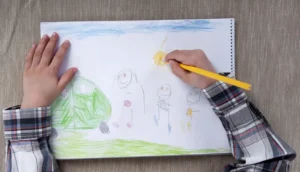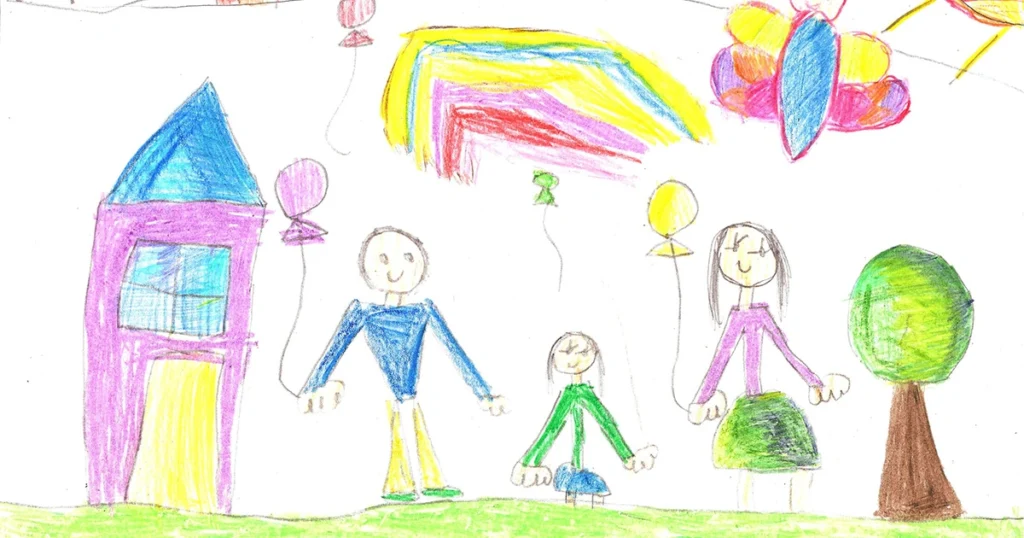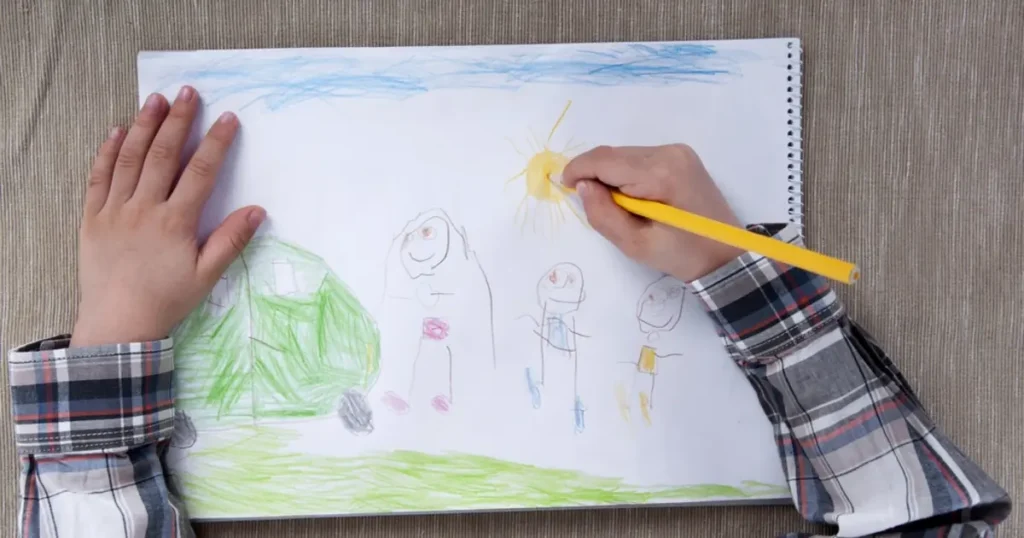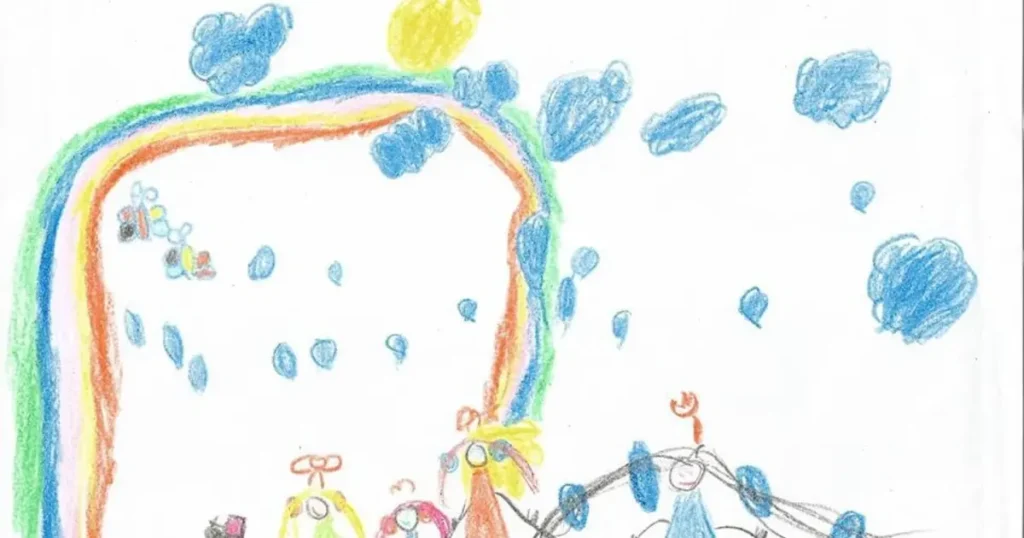What Do a Child’s Drawings Reveal?
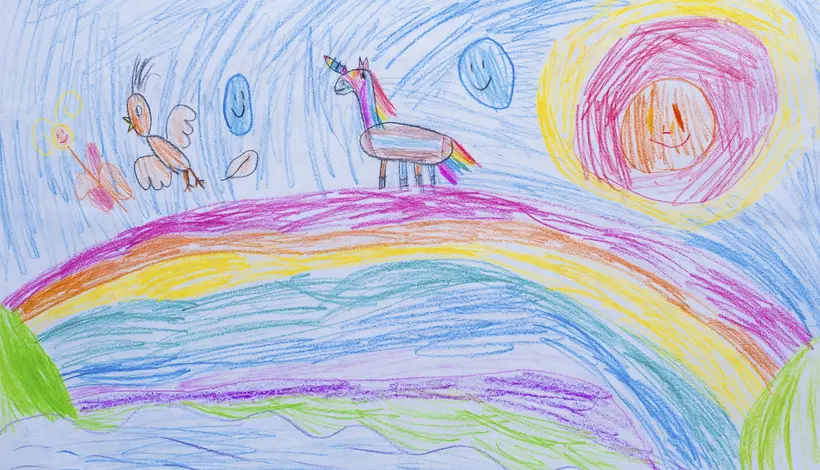
Drawings are a child’s way of visually expressing people, objects, landscapes (such as mountains, seas, or cities), and even natural phenomena (like the sun, rain, or snow). For generations, drawing has been an inseparable part of children’s favourite creative outlet during their early years. This stems from the fact that drawing—whether alone or in groups—is a beloved activity for children, allowing them to explore their imagination freely. Typically, drawings are created on paper, often using a sketchbook, with popular materials including coloured pencils, markers, crayons, and tempera paints with brushes. The sketchbook becomes a canvas that hosts these young creations, crafted with an array of tools.
The Joy of Drawing for Children
Engaging in drawing is a delightful activity for young children. When creating a drawing, they feel free to express whatever they desire, using any materials they choose. Beyond personal expression, drawing also fosters social connections. Children share ideas, discuss their artwork (or unrelated topics), find common ground, and often lay the foundation for lasting friendships in the years to come.
A Creative Outlet Without Limits
Drawing is a highly creative pursuit for children for numerous reasons. It allows their imagination to run wild, enabling them to create anything they envision simply by putting pencil to paper. Their creativity knows no bounds, as they can use any colours they like, even if they seem unconventional—such as painting grass red or the sky green—without it feeling strange to them. As the writer Nikos Kazantzakis[1] once said, “You have the colours, you have the brushes, paint paradise and step inside.”
Simultaneously, drawings offer children a chance to depict their ideal corner of the world, reimagining places they love through their imagination, regardless of how realistic the result may be. Through their artwork, they travel to fantastical destinations and leave their unique mark on how they perceive the world. In children’s drawings, imagination reigns supreme, often overshadowing or reshaping reality.
Symbolism in Family and Home Depictions
It’s fascinating how children choose to represent their family and home in their drawings. They often depict their house with grass, trees surrounding it, and a small path leading away, symbolising a safe and stable environment (the trees) and a desire to explore the world (the path). The house itself is typically drawn as a square with two windows, a door, and a roof with a chimney—a common design that reflects familiarity.
Next to the house, children usually draw family members, with parents portrayed as taller and more robust compared to themselves and their siblings, whose heights vary with age. At the top of the drawing, a smiling yellow sun and a light blue sky are frequent features, suggesting a sense of security, carefree joy, and optimism. This typical drawing indicates that children feel safe within their family environment, observing the world from the comfort of their home.
Understanding Children’s Drawings: Analysis and Insights
🏷️ Only £70 per month
⏱️ Duration: 2 hours per week for 10 months
👨🏫 Taught by human instructor
💻 Remote Live learning
📖 Free study notes and resources
🎓 Option to receive a certificate of completion
Drawings as a Mirror of the Child’s Soul
The way children depict their family environment in drawings reveals that this creative activity is not just enjoyable but also a reflection of their inner world. Through their artwork, they express emotions and experiences they’ve lived through. Each drawing tells a story that parents, educators, psychologists, and other professionals working with children should pay close attention to.
Drawing is a form of non-verbal storytelling, classified as a visual narrative. It serves as a medium through which children communicate their feelings, and in some cases, it becomes a cry for help directed at concerned adults.
Emotions Reflected in Colours and Sizes
Children’s drawings are a window into their emotions, with the colours they choose revealing their current state of mind. A dominance of red or its shades may indicate anger or sadness (e.g., after a disagreement with parents or siblings). Black or grey tones suggest a difficult period or deep sorrow, while earthy colours (green, blue, yellow) reflect carefreeness, calm, security, and optimism.
The sizes children use to draw people, objects, or environments also carry meaning. A drawing of a school or park with small, happy children playing suggests a carefree childhood filled with friends. Conversely, a drawing of a tiny, sad child surrounded by oversized, threatening peers may indicate fear, possibly due to bullying or witnessing violence, leaving the child feeling unable to speak out.
Drawings as Indicators of Trauma
Children’s drawings can also reflect traumatic experiences. The loss of a parent is a painful event that many children struggle to overcome, often expressed through dark, mournful colours or scribbled drawings that convey grief and despair, seeking an adult’s attention. Similarly, a painful parental divorce may be depicted with a broken home, an absent parent, and dark shades, reflecting the child’s emotional turmoil.
The Importance of Understanding Drawings
Parents should never overlook their children’s drawings, as they mirror their inner world. Decoding the symbols within these artworks helps parents gauge their child’s happiness or distress, enabling them to address issues like bullying or family challenges. Parents who understand these symbols become more attuned to their children’s needs, offering support during difficult times.
This practice has extended into psychology, pedagogy, and psychoanalysis. Psychologists use drawings in initial sessions to build trust with a child, while educators who interpret these artworks can prevent bullying and assess whether a child lives in a healthy or troubled family environment. Social workers and criminologists also rely on drawings to evaluate family safety or determine if a child has witnessed a crime.
The Role of Drawing in Emotional Expression and Development
Drawing serves as a vital tool for children to process and express their emotions, particularly during times of change or challenge. Psychologists note that children often turn to art when words fail them, using drawings to navigate complex feelings such as anxiety, excitement, or grief. For instance, a child experiencing a significant life event—such as moving to a new city like Birmingham or starting school in London—might depict their home with exaggerated details or omit certain family members, offering clues about their emotional state.
At OnSeminars, our Understanding Children’s Drawings: Analysis and Insights seminar teaches participants how to recognise these subtle signs, equipping parents and educators with the knowledge to support children through transitions. By understanding the emotional narratives embedded in these artworks, adults can foster a safer, more supportive environment, which is crucial for healthy emotional development.
Moreover, drawing encourages cognitive and motor skill development, which are foundational to a child’s growth. The act of selecting colours, shaping figures, and filling spaces on a page helps refine fine motor skills and enhances problem-solving abilities. Research from the UK’s Early Years Foundation Stage (EYFS) framework highlights that creative activities like drawing boost concentration and self-esteem, benefits that are especially pronounced in pre-school and primary school children.
For parents in the UK, recognising how these skills evolve through drawings can provide valuable parenting tips, allowing them to nurture their child’s potential effectively. Our seminar delves into these developmental aspects, offering practical strategies to interpret how a child’s artistic progress mirrors their learning journey, making it an essential resource for those in educational or caregiving roles.
Cultural Influences on Children’s Drawings
The cultural context in which a child grows up significantly shapes their drawings, reflecting societal values, traditions, and even local environments. In a diverse city like London, where over 300 languages are spoken, children might incorporate multicultural elements into their artwork—such as drawing festivals like Diwali or Christmas alongside familiar landscapes.
These cultural markers can reveal a child’s sense of identity and belonging, providing a window into how they perceive their place in the world. Similarly, children in Birmingham, with its rich industrial heritage, might depict factories or canals, blending personal experiences with local history. At OnSeminars, we explore how these cultural influences manifest in drawings during our Understanding Children’s Drawings: Analysis and Insights seminar, helping participants decode the broader context behind each stroke and colour choice.
This cultural lens also extends to how children perceive authority figures or community roles, which can be observed in their depictions of teachers, neighbours, or even public services like the police. For example, a child who draws a large, smiling teacher might feel secure in their school environment, while a smaller, distant figure could suggest unease. Understanding these nuances is particularly relevant in the UK, where multicultural classrooms are common, and educators need to be attuned to diverse emotional needs. By attending our seminar, professionals and parents gain insights into how cultural backgrounds influence drawing styles, enabling them to tailor their support and interventions more effectively, fostering inclusivity and understanding.
The Therapeutic Potential of Drawing in Professional Settings
Beyond the home, drawing has become a powerful therapeutic tool in professional settings, particularly in child psychology and counselling. In the UK, the National Health Service (NHS) increasingly recognises art therapy as a means to help children process trauma, with drawings serving as a non-verbal bridge to discuss difficult topics. For instance, a child who has experienced bullying might draw a chaotic scene with dark colours, which a trained therapist can use to initiate a conversation about their feelings. Our Understanding Children’s Drawings: Analysis and Insights seminar trains participants in these therapeutic techniques, offering guidance on how to facilitate safe discussions based on a child’s artwork, a skill that is invaluable for psychologists, social workers, and educators.
This therapeutic approach also benefits children with special educational needs or developmental disorders, such as autism or ADHD, where verbal communication may be challenging. Drawings allow these children to express themselves in a controlled, creative space, providing clues about their sensory preferences or emotional triggers.
Conclusion
Children’s drawings are far more than a creative pastime—they are a powerful tool for understanding a child’s emotions, experiences, and needs. For parents, educators, and professionals, learning to read these visual narratives can make a significant difference in a child’s life, fostering support and intervention where necessary.
Support Children with OnSeminars
At OnSeminars, we’re dedicated to empowering you with the skills to understand and support children through their artwork. Our Understanding Children’s Drawings: Analysis and Insights seminar provides practical techniques to interpret drawings, helping parents, educators, and professionals identify emotional cues and address potential concerns.

